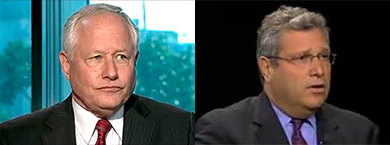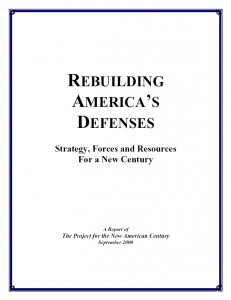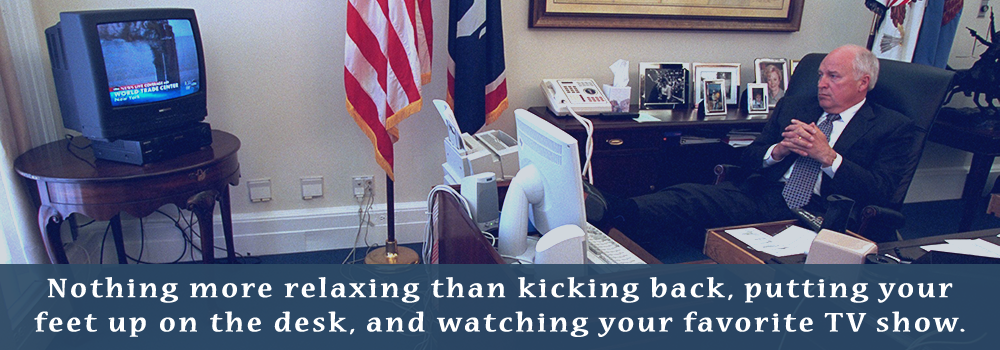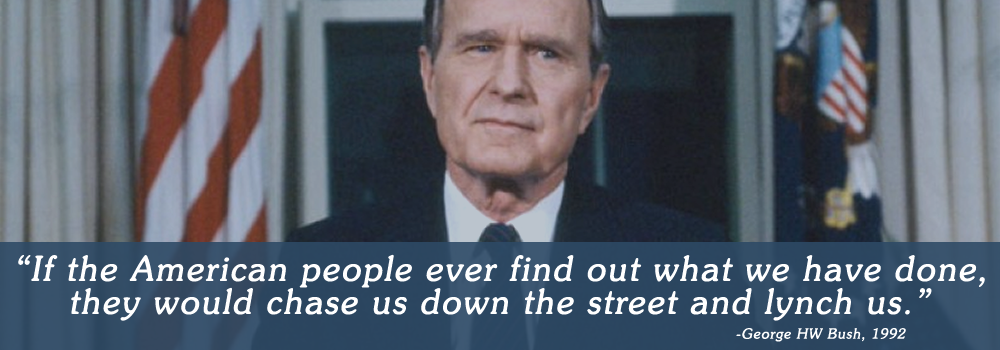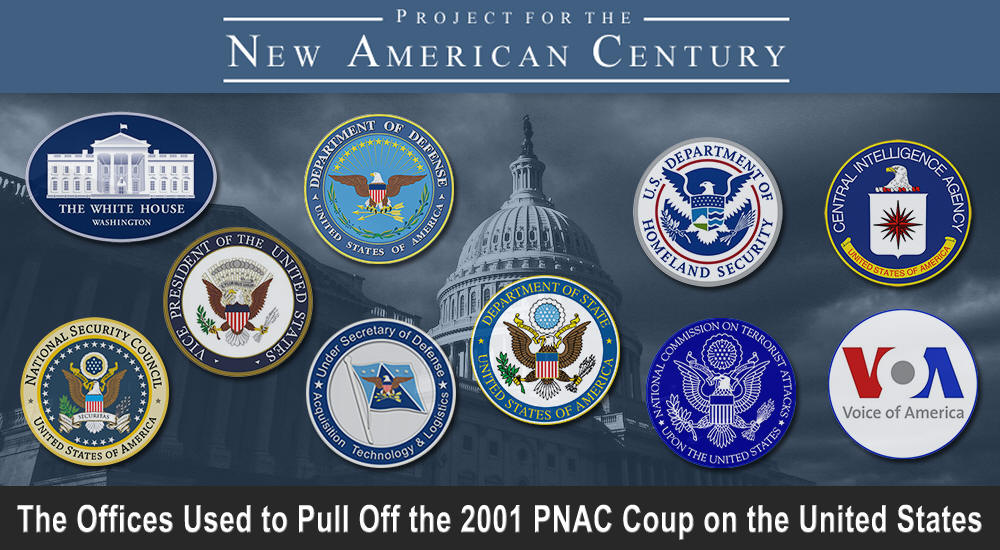 |
||||||||||||||||||||||||||||||||||||||||||||||||
|
||||||||||||||||||||||||||||||||||||||||||||||||
 |
||||||||||||||||||||||||||||||||||||||||||||||||
|
Here
Are the PNAC
Members Embedded Within the Bush-Cheney Administration |
||||||||||||||||||||||||||||||||||||||||||||||||
|
||||||||||||||||||||||||||||||||||||||||||||||||
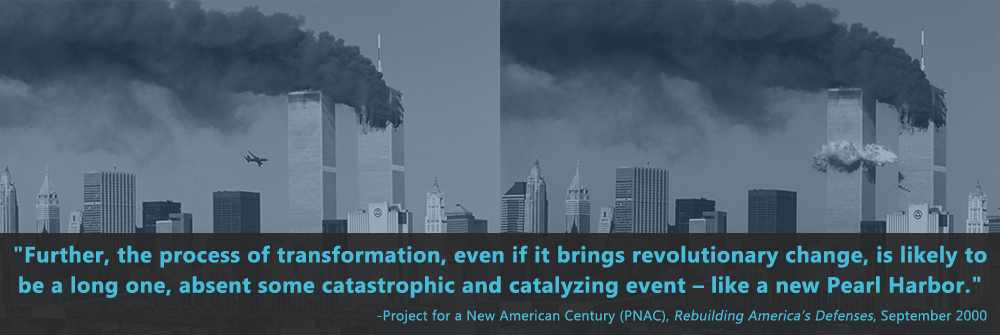 |
||||||||||||||||||||||||||||||||||||||||||||||||
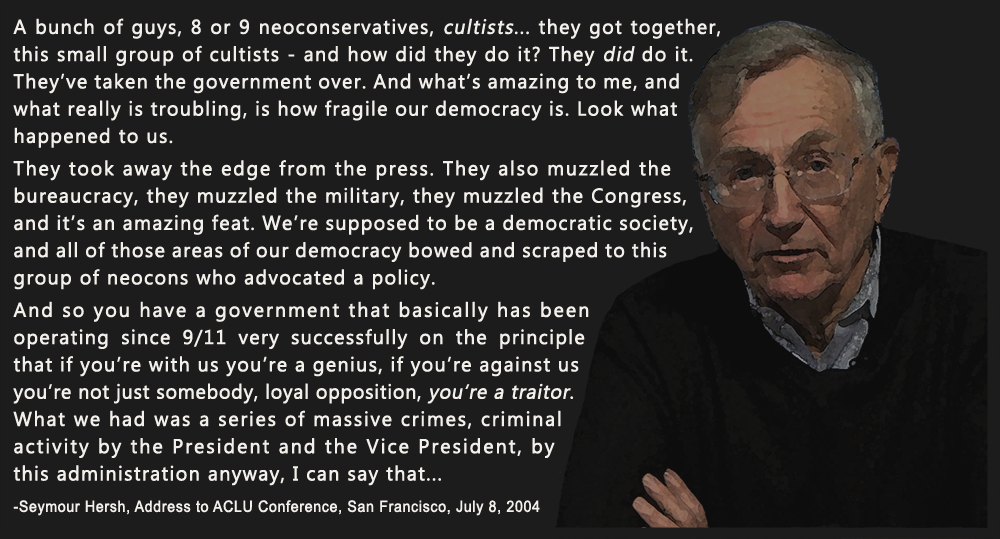 |
||||||||||||||||||||||||||||||||||||||||||||||||
|
Preface: What you are about to read is historical truth. It shows a clearly conceived, meticulously planned, concerted effort to take over full control of the United States, wresting it from its Constitutional base and thrusting it into a post-9/11 fascist dictatorship. Congress is now but an ancient relic of "we the people," working tirelessly to enslave all in a new system, under the guise of post 9/11 safety from the War on Terror.
The group reached infamous notoriety when knowledge of their pre-9/11 wish for a "new Pearl Harbor" in the US went public, as documented in their policy paper, "Rebuilding America's Defenses." The document was essentially a manifesto for world dominance. The group recognized that such a radical blueprint could not be achieved quickly, not without adverse public reaction. Everything covert is always done in clandestine steps, to keep the public in the dark. It is with that recognition that they wrote the following heinous wish... "Further, the process of transformation, even if it brings revolutionary change, is likely to be a long one, absent some catastrophic and catalyzing event – like a new Pearl Harbor." As evidenced from that statement, this was an essential key, critical point that was clearly not lost on this group. So, extreme doubt was cast as to how fast these aims could be achieved, even under a right-wing administration. They needed a powerful catalyst that would force Congress and the US public to go along with their treasonous plan for alleged US imperialism and dominance. (More on the "alleged" aspect as you read onward.) By their own numerous admissions, they needed a new Pearl Harbor. What many don't know is that the genesis for the plan came from the administration of George H.W. Bush, through another infamous document of notoriety, the 1992 Defense Policy Guideline (DPG). The Start of the Takeover With the "fall of the wall" in 1989, and its ensuing demolition in 1992, there were many war-hawks who believed that deep military spending would no longer be possible. Under the auspices of the George HW Bush administration, Dick Cheney, along with his minions, was tasked to concoct and fabricate a never ending cause to fund war for all time. This became the '92 DPG, a highly classified document conceived by Zalmay Khalilzad, Paul Wolfowitz, and I. Lewis (Scooter) Libbey, under then US Defense Secretary Dick Cheney. (Some say Gary Schmitt also had a hand in this.) Only the original 46 page draft has ever been revealed to the public, while a much revised final version is reported to still be classified. (Scooter Libby is reported to have re-worked the final draft of the DPG document, altering the verbiage to disguise its intent and make it more palatable for those feint of heart.) It should be made clear that "Defense Policy Guideline" (DPG) is not the name of the plan itself, but is merely an internal set of military guidelines, a policy outline, which is usually prepared every two years. This is very much akin to the National Defense Authorization Act (NDAA) which is also produced every year or two. Before its first draft took even place, critical consultation was sought from staunch neoconservatives such as Albert Wohlstetter, Richard Perle, and Andrew Marshall. It was a neocon plan right from the start, from its conception to its inception. The trouble started when a copy of the draft DPG was secretly leaked to the Washington Post and New York Times. Public outcry was high, because the document was calling for some very un-American things, primarily a new way of thinking militarily. The plan contained an outlandishly brazen demand for a huge increase in defense spending, even though we were already outspending the rest of the world, combined. The stated goal of the DPG plan was for "US supremacy," not allowing other nations to rise up to rival the United States, while proposing to freely intervene in foreign disputes whenever it saw fit, even if they have nothing to do with US policy or interests. It also suggested that the US act aggressively on its own, if nation coalitions could not be built, forgoing multilaterlism altogether. Then there was one other thing that deeply worried many... the DPG stated that the US must “show the leadership necessary to establish and protect a new order that holds the promise of convincing potential competitors that they need not aspire to a greater role or pursue a more aggressive posture to protect their legitimate interests.” T he biggest shock came with the suggestion that the U.S. should set about to "shape circumstances before crises arrived."This was a shocking and unprecedented call to adopt "preemptive warfare," as a national policy, something which the US had never publicly stood for ever before (much like torture).The 1992 DPG plan called for:
Remember, this was all in 1992, so what were HW Bush and Cheney up to way back then, long before 9/11? Whatever, it was all clearly quite contrary to long established American principles, and so after much public furor, the DPG was allegedly said to be pulled, but in all reality, it went underground, as a pet project for the neoconservatives. Defense Secretary Cheney was apparently so utterly enamored with the DPG proposal, he reportedly told Zalmay Khalilzad, “You’ve discovered a new rationale for our role in the world.” That's a horrifically creepy statement to make for most normal people, but considering that it came from the dark lord of the Sith, it's simply par for the course - business as usual for one Richard Bruce Cheney, known to some as "Deferment Dick," due to the five deferments he requested to keep himself out of Vietnam. Once the timid, quivering chicken-hawk, he suddenly became quite the tenacious war-hawk once placed in a position of government power.
Before the DPG was shelved, both Cheney and then President George H.W. Bush made every effort to save this plan, going out of their way to sell the proposal to Washington. CFR media mouthpiece Charles Krauthammer was used to help promote the plan. He wrote in his Washington Post column, “What is the alternative? The alternative is Japanese carriers patrolling the Strait of Malacca, and a nuclear Germany dominating Europe”
Wow.
Talk about resurrecting bad memories of horrors past.
That reference was obviously a deliberate ploy to bring up already pre-conditioned fears from WWII, much as they did immediately after 9/11, with their numerous references to "Pearl Harbor." (see more on this further ahead)
Try as they did, the Defense Policy Guidance (DPG) plan was shelved - for the time being - but a dark seed had already been planted... and taken root.
Work Continues Behind the Scenes
Just two years later, in 1994, a new non-profit organization, the New Citizenship Project was formed, with political commentator William (Bill) Kristol as chairman and Gary J. Schmitt as president. It was largely funded by many private conservative donors and right-wing foundations. Their mission statement... "An organization created to promote greater civic participation in our national life."
For all intents and purposes, it is the same organization of people, with two
different shingles on the same door.
A current US website no longer exists, however, Sourcewatch has more on
the original New Citizenship Project.
As an aside, according to his US Senate bio, John McCain is reported to have served as a past president of the NCP.
(NCP would eventually be the group that led to the 1997 Project for the New American Century.)
1996: A Very Busy Year When it comes to neocon treachery, 1996 was indeed a very big year, because these same neoconservatives decided to get busy. Very busy.
They formed the US Committee to Expand NATO, which later became the US Committee on NATO.) Neoconservatives Bill Kristol and Donald Kagan co-authored a piece called "Toward a Neo-Reaganite Foreign Policy," another cornerstone in their plan for complete control of US policy.Also in 1996, another dark document was conceived and written for the IASPS, the Institute for Advanced Strategic and Political Studies, with dire implications for the middle east. It was entitled "A Clean Break - A New Strategy for Securing the Realm," penned by neocon co-authors David Wurmser and Richard Perle. It formed the basis for the middle east wars which would take place post-9/11. Most have given credit to Douglas Feith, but he now denies being a "main" contributor, although admits to be consulted on the paper before its publication.
1996 was indeed a very fruitful year for the neocon planners, but the next two following would prove just as successful for them, while even more disasterous for the country.
In 1997, the Project for a New American Century was finally born, the PNAC. Spawned from the skewed right-wing brain-trust of neocons William Kristol and Robert Kagan, their sole purpose was to form a new US policy... one that was overly aggressive and self aggrandizing, espousing the US as supreme over all. (In reality, the "supreme US" is all a ruse, which will be explained further on.)
In its founding statement of principles, just like the DPG draft, the PNAC statement called for U.S. global leadership and preemptive action, stating,
"Of course, the United States must be prudent in how it exercises its power. But we cannot safely avoid the responsibilities of global leadership or the costs that are associated with its exercise. America has a vital role in maintaining peace and security in Europe, Asia, and the Middle East. If we shirk our responsibilities, we invite challenges to our fundamental interests. The history of the 20th century should have taught us that it is important to shape circumstances before crises emerge, and to meet threats before they become dire. The history of this century should have taught us to embrace the cause of American leadership."
While this is indeed neoconservative rhetoric, it also highlights their thinking at that particular moment in time. The mid to late 90's, as it now appears in 20/20 hindsight, is where things really started getting out of control with the neocon plan for redirecting US policy.
“Show the leadership necessary to establish and protect a new order."
Defining Catastrophic Terrorism The evidence of a clear effort to take down the US becomes even more transparent just a year later in October of '98, when yet another dark document was conceived, called "Catastrophic Terrorism: Elements of a National Policy."
If that title alone isn't enough to raise the ol' Spock eyebrow, then you are more than likely incapable of sentient reasoning.
But let's hold on a minute here - just one short brief second... "Catastrophic Terrorism"... as a National Policy?
Seriously?
Well, that's exactly what the public and other government watchdogs were asking back then as well, and so guess what? All of a sudden - magically, overnight - that document suddenly had a new name... Catastrophic Terrorism: "Tackling the New Danger."
So, using our 20/20 hindsight once again, was that earlier title all just some form of eerie prescience, or was it an actual revealing preview of their true intended plans for this country?
Thinking minds shouldn't have to parse that one about for too long.
Then there was the issue of that little subtitle... "Imagining the 'transformative event.'"
Seriously?
There are two key components to that title... the act of "imagining," as well as the "transformative event," the latter of which is actually two more things unto itself - something "transformative," and in the form of an "event."
Perhaps the only title more telling about its authors might have been "Daydreaming about the transformative event."
A very telling admission/concession of guilt came in the form of a later revision which shamelessly changed the subtitle to its present version, "Visions of Governance for the Twenty-First Century."
Although, even that small revision reveals much about this group and its plans, because it blatantly spells out in its revised title, a new type of US governance is being implied.
Seymour Hersh should have to look no further than this treasonous moment in history for indications of a coup.
Imagining Catastrophic Terror
This new policy proposal was the byproduct of yet another tiny micro-group of neoconservative men, Ashton B. Carter, John Deutch, and Philip Zellikow. At the time, only John Deutch was publicly well known as the former Deputy Secretary of Defense from 1994-95, and Director of the CIA from 1995-96. Phillip Zellikow would "coincidentally" be later named as the head of the 9/11 Commission, while Ashton B. Carter would later become Secretary of Defense.
The thing most damning about the Catastrophic Terrorism (CT) study was their joint speculation on what would have happened had the 1993 World Trade Center bombing brought down the twin towers... "Such an act of catastrophic terrorism would be a watershed event in American history. It could involve loss of life and property unprecedented in peacetime and undermine America's fundamental sense of security, as did the Soviet atomic bomb test in 1949. Like Pearl Harbor, this event would divide our past and future into a before and after. The United States might respond with draconian measures, scaling back civil liberties, allowing wider surveillance of citizens, detention of suspects, and use of deadly force." The proposal then suggests, "More violence could follow, either further terrorist attacks or U.S. counterattacks." These members of the CT study also wrote: "Readers should imagine the possibilities for themselves, because the most serious constraint on current policy is lack of imagination. An act of catastrophic terrorism that killed thousands or tens of thousands of people and/or disrupted the necessities of life for hundreds of thousands, or even millions, would be a watershed event in America’s history. It could involve loss of life and property unprecedented for peacetime and undermine Americans’ fundamental sense of security within their own borders in a manner akin to the 1949 Soviet atomic bomb test, or perhaps even worse. Constitutional liberties would be challenged as the United States sought to protect itself from further attacks by pressing against allowable limits in surveillance of citizens, detention of suspects, and the use of deadly force. More violence would follow, either as other terrorists seek to imitate this great "success" or as the United States strikes out at those considered responsible." "Like Pearl Harbor, such an event would divide our past and future into a before and after." "Using imagination, we hope now to find some of the political will that we know would be there later, "after," because this nation prefers prevention to funereal reconstruction. When this threat becomes clear the President must be in a position to activate extraordinary capabilities." This isn't a proposal as much as it is a full out plan... neocon daydreaming on how to take down the United States. Resurrecting an Evil Plan Two years later, in the fall of 2000, they put it all together with a supposedly new document which was curiously titled, "Rebuilding America's Defenses," (RAD) and once again co-authored by nothing more than a mere diminutive trio of neoconservative men, Thomas Donnelly, Donald Kagan and Gary Schmitt. The title was certainly intriguing enough, since America had never lost its defenses to begin. The impetus to increase military spending was a huge red flag.
A disturbing common theme would soon present itself within this document, the reoccurring suggestion of another Pearl Harbor within the US. This was apparently a very wet dream for treasonous neocons - an extreme fascination, to say the very least. TWO documents referencing a "new Pearl Harbor" for the US, both written before 9/11. That is not a coincidence. Essentially, the alleged new manifesto, "Rebuilding America's Defenses," was nothing more than an old blueprint... the 1992 DPG! Quite literally, RAD was cut directly from the DPG. All they did was dust it off and put a new title on it. As a matter of fact, it states right in Rebuilding America's Defenses... “In broad terms, we saw the project as building upon the defense strategy outlined by the Cheney Defense Department in the waning days of the [George H.W.] Bush Administration. The Defense Policy Guidance (DPG) drafted in the early months of 1992 provided a blueprint for maintaining U.S. preeminence, precluding the rise of a great power rival, and shaping the international security order in line with American principles and interests. Leaked before it had been formally approved, the document was criticized as an effort by ‘cold warriors’ to keep defense spending high and cuts in forces small despite the collapse of the Soviet Union; not surprisingly, it was subsequently buried by the new administration [of Bill Clinton].”
This is substantial proof that once they developed the original DPG plan, they did not let it go, despite it being shot down by the press and the public in 1992. What this shows is the treacherous resolve of this neoconservative group. They knew what they wanted, and were patient in getting it.
This 2000 document would soon become the single harbinger of evil for the people of the US, and the world as well. "A transformation strategy that solely pursued capabilities for projecting force from the United States, for example, and sacrificed forward basing and presence, would be at odds with larger American policy goals and would trouble American allies." "Further, the process of transformation, even if it brings revolutionary change, is likely to be a long one, absent some catastrophic and catalyzing event – like a new Pearl Harbor." Just to be clear... there you have the neocon Pearl Harbor dream, blatantly, purposefully expressed, once again. A reinforcer for the warped thinking of its earlier predecessor, the infamous DPG draft.
As coincidence would have it, the damning RAD document was first published just one year, to the month, prior to 9/11, in September 2000. (Author Barbara Honegger says it was actually published on September 11, 2000.)
What happened afterward is yet another dark chapter of tainted US history.
Setting the Stage
When it comes to the numerous repeated references to "Pearl Harbor," it was all very deliberate. It was literally an elaborate mass conditioning scheme, to get people to once again accept the "great lie," as they did leading to WWII.
As coincidence would have it... conspicuously enough, the $450-million dollar movie blockbuster "Pearl Harbor" was also released early that year, in May of 2001, settling the horror of Dec 7, 1941 back into the public consciousness.
Add to that, this disturbing account. According to author Barbara Honegger, Defense Secretary Donald Rumsfeld had given out literally hundreds of copies of Pearl Harbor; Warning and Decision that year, written by Rand employee Roberta Wohlstetter. It was also reported to be required reading for Rumsfeld's personal aides.
With a multi-trillion dollar War on Terror looming on the horizon, this was not a coincidence.
The PNAC set the stage and then they played it for all its worth. This group was literally the poster-child for all things non-Constitutional mayhem post 9/11, most especially the run-up to the Iraq War.
Preceding the war, key PNAC members such as Paul Wolfowitz and Richard Perle beat the drum for war with Iraq. According the Vanderbilt Television Archives, Wolfowitz was on 180 times to sell the war while Perle was on 187.
They were programming the American public to not only accept their ruse, but then act upon it using classical conditioning methods.
And as history shows, it seems to have worked pretty damn well.
For the Record In 2001, after the United States Supreme Court violated US law by usurping Congress' authority to recount the 2000 election, George W. Bush was selected to be the next president of the United States. Just as conspicuously as his questionable appointment, he filled his administration at key positions of power with neocon members of the PNAC. (see the table above) The historical record is quite clear about an agenda based group of PNAC individuals taking over the White House and the US government. Reporter Seymour Hersh of The New Yorker, publicly addressed an ACLU convention in San Francisco in 2005 about this topic, when he stated in no uncertain terms, "A bunch of guys, eight or nine neoconservatives, 'cultists,' they got together, this small group of cultists... and how did they do it? They did do it. They've taken the government over." But for that bony pointing finger of Hersh, few dared to stand up to the pre-arranged conditioning of not questioning the Bush-Cheney administration's "You're either with us, or you're with the terrorists" stampede on the US Constitution and human rights. Few dared to stand up back then and publicly say that there had been a coup on this country, the United States of America, but Hersh said it point blank, and even named those who took it over. One other person who did notice was Jim Lobe of the Inter Press Service (IPS). He was also one of the astute observers who were noting the similarities with the new Bush Doctrine and the War on Terror. He reported, in no uncertain terms, that the original authors of the DPG had become deeply entrenched in positions of high office within the George W. Bush administration - referring to Dick Cheney, Paul Wolfowitz, "Scooter" Libby, and Zalmay Khalilzad.
That unsavory collaboration would soon grow. They were later joined in their treasonous effort by the signatories of Rebuilding America's Defense... Donald Rumsfeld, Elliott Abrams, and Peter Rodman. That was not the end of it though. The engineering of the neocon takeover of America didn't stop with just Rebuilding America's Defenses, because three years later in 2003, the Project on Transitional Democracies (POTD) was created under the US Committee on NATO, by PNAC members Bruce Jackson, Randy Scheunemann, and Julie Finley. This group created quite the trail of damning policy change in just eight short years time, leading directly from the administration off daddy dearest, HW, to the next Bush in the chain of command, the selection of his son W. Bush. True Intent Each of these PNAC proposals were essential pieces to the overall master plan, the takeover and dissolution of the United States, the latter of which is totally contrary to their stated principles, but as many have already figured out, the inevitable outcome of this has already been deviously engineered into the deployment of their aggressive plan, in the form of blowback and retaliation from those oppressed and infuriated by the plans eventual overall execution. Perhaps most telling of all, the PNAC website (www.NewAmericanCentury.org) and the POTD website (www.PTdemocracy.org) have both been removed from the internet. What's the old saying about having nothing to hide? Long story short folks, if you haven't figured it out by now, this was an illegal coup on the United States of America. Period. End of discussion. What people need to do now is familiarize themselves with each of these people that were behind this coup, recognize their treachery, and then ask for their immediate arrest and prosecution for treason. It is clear that the offices needed to steal the policy of this country and take it into unprovoked war were all occupied and run by PNAC coup members. One of them with perhaps an even more significant contribution would be Dov Zakheim, who was not only the DoD Comptroller in charge of finding the missing $2.3 trillion in Pentagon money, but he has also been directly linked to SPC, which coincidentally just happens to specialize in making remote control drone flight (and destruction) possible. According to Michelle Ciarrocca and William D. Hartung's book, "Axis Of
Influence: Behind the Bush Administration's Missile Defense Revival," World
Policy Institute Special Report, July 2002... When it comes to the US neoconservative movement, there appears to be dirt from 9/11, no matter where you turn, yet, this is but only the tip of the iceberg. Follow the Money There is big money $$$ behind the PNAC, and not just the paltry contributors... In its first year alone, the PNAC received many lucrative grants from the Bradley, Scaife, and Olin foundations.
According to RightWeb.irc... f rom 2000 to 2005, the PNAC received $241,735 in (known) grants from several conservative foundations.
The Bradley Foundation was the PNAC's largest source of foundation support, giving PNAC $800,000 from 1997 to 2005. RightWeb also states, "From 1994 to 2005, the New Citizenship Project, which sponsored the PNAC and whose chairman was Kristol, received $3.5 million in grants, mostly from many of the largest right-wing foundations." That is not the only money trail to follow though... There is also the huge elephant in the room with the issue of the missing $2.3-trillion dollars from the Pentagon. Rumsfeld announced it the day before 9/11, but he was not being totally honest during his allegedly frank speech. First off, the $2.3-trillion was not from the year before, it was two years before, in 1999. Second, according to Congresswoman Cynthia McKinney, there was another $1.1-trillion dollars missing in 2000. For those doing the math at home, that's a whopping $4.4-TRILLION dollars total that was mysteriously missing. So why didn't Mr. Defense Secretary, a guy who was intimately aware of DoD numbers, say anything about that? Surely he knew the difference from "the year before" and two years before, yet he chose to hide the total amount. Perhaps because, very likely, that missing money was the seed cash used to orchestrate, engineer and pull off 9/11. Rumsfeld apparently didn't want the American public to know how much money had actually been ripped off. Make no mistake about it... there is a huge money trail to follow regarding 9/11, both before and after. Altruism or Deceit This group claims to actively work for US domination of the world and also space. It claims its purpose is to further US supremacy in the world, however, it's actions speak louder than its words. If their actions are so altruistic and benevolent for society, then why is it that when they get exposed, they run like scared little girls and close up shop? All of these heritage sites, for each cause, have been shamefully removed from the internet. http://www.newamericancentury.org PNAC http://www.iasps.org IASPS POTD CTSEvery single one of these sites have been mysteriously taken down. That in itself should be highly suspicious to even the dimmest of junior detectives. It clearly looks like somebody got scared and tried to hide the evidence. The organizations behind these sites either silently disappear into the shadows from whence they came, or else they change their name and continue on with business as usual, like the PNAC switch to FPI. Whichever tactic, this undeniably demonstrates a concerted effort to keep themselves hidden as a group, and to withhold this information from the public, which should tell you everything you need to know about the lawfulness of their intent. If these were truly altruistic and benevolent endeavors, then why have many of these micro-organizations suddenly closed up shop, or changed their names once the public outcry began? Let's look at it this way... If three men wrote about a possible plan on how to rob the 1st National Bank, and then three other men wrote about a plan to rob the same bank, in the exact same fashion, and then the bank is robbed exactly as described by the previous six men, you can bet your ass that those six men would be behind bars, if not just for questioning alone. So why is it so f#@-ing hard to get anyone in a position of authority to recognize this and do something about it? The only answer I can think of is that all the higher authorities have been taken over, or they're too chicken-shit scared to do anything about it. Let's look at the facts While in full control of the Bush-Cheney administration, the US Constitution and our citizen rights were aggressively attacked and egregiously curtailed, all due to their neoconservative treasonous policies which were set in place prior to 9/11, showing nefarious intent to many researchers who often scrutinize the historical record with a new, more informed and knowledgeable hindsight. Much has been done to undermine the sovereignty of this country, under both Presidents, Bush and Obama. By every definition, the preceding actions of this secretive neocon organization prior to 9/11 have been a literal blueprint for enabling this bogus War on Terror. They have indeed been the enablers to it all. First they said it was Osama bin Laden and al Qaeda. Next it was the Taliban that we were supposed to worry about. Then they said it was Saddam and the Iraqi's, with their "weapons of mass destruction". Then they said it was possible Iranian connections to terrorism. Now they're saying it was Saudi Arabia connections to 9/11. A never-ending supply of bullshit and fear porn. Everyone gets the blame post 9/11, except for the neocons and their US and Israeli supporters who planned it all. The fact that the mainstream corporate media has said virtually nothing about this infiltration of the US government by a private neoconservative group of individuals, with foreign ties to another government, that is quite telling in itself. It tends to substantiate and corroborate allegations that the media is a disinformation and propaganda conduit of the government, supported by the ultra-wealthy powers that be. Another point of contention is the fact that this secretive group is also a key sister organization to another covert group, the Israeli organization known as IASPS, the Institute for Advanced Strategic and Political Studies. (Responsible for Clean Break: A New Strategy for Securing the Realm.) The two plans together, Rebuilding America's Defenses, and A Clean Break, both dovetail together as one plan, with a singular agenda and objective. One could rightfully suggest that there may be more than just these two uncovered plans in play. There very well could conceivably be at least two more plans, covering both the EU and Asia, but they have yet to surface in the public domain. I've said it many times over and I will keep repeating it every chance I get... The Taliban did not create the IASPS or the PNAC. Al Qaeda didn't draft the "Clean Break" document, nor the 1992 DPG, or the 2000 "Rebuilding America's Defenses" document. Isis is not the one changing US law or restricting your Constitutional rights. Our politicians did all of this to you... to all of us... and yet they themselves are but minions to the powers that be (TPTB), puppets to the uber-rich marionettes who rule this world with indifference for all but themselves. Allegedly... these neoconservative idealists did it all so that they could perpetuate their plan for US supremacy through the "New American Century," but in all reality, it's about the demise of the US, for a one-world globalist rule.That may be hard to accept, or even fathom for some, but one only needs to look at what's happened to the US post 9/11 as a result of their covert national policy changes. The Moral Descent of the US Since 9/11 The country hasn't risen in the world's eyes, it has fallen. Since 9/11, we have given in to everything that this country never stood for... all due to tiny neocon micro-organizations pushing anti-democratic and anti-constitutional policy, sometimes under a minimal staff of two or three people, yet heavily funded by those with the ultra-big money $$$. These policy changes have brought unwelcome change to the US...
Make no mistake about it, these are all repercussions resulting from the actions of a secretive neoconservative group that claims, it wants what's best for America. Well... is starting unlawful, unprovoked war with another nation, and slaughtering hundreds of thousands of their people, just to steal their natural resources and erect a military foothold in the region... all the while sending our own sons and daughters to fight and die in wars that have all been outright lies to the US people and the world... is THAT what's best for America? Perhaps it's only what's best for the neocons. In all reality, this may be just part of the final steps to the one-ruler new world order, to take down the last great superpower, not only from within, but through international disapproval and disdain from the outside. What's in a Name? So let's examine that term for a moment, "neoconservative," or "neocon." What is neoconservative? This a a very far-right conservative movement, fascist by any other name, and one with deep ties to Israel. These men help promote American-Israeli policy, arguably with allegiance and deference to Israel first. When you examine their organizations and anti-constitutional actions, a disturbing comparison immediately comes to mind for those from an older generation, not so far removed from WWII. In it's basic essence and form, it very much resembles all the principles of right-wing fascism. This isn't such a stretch when you understand US history and WWII. First off, the nation of Israel was actually born out of WWII, as a decades long plan by the Rothschild's, and then brought to fruition under the crown (Balfour document) and reestablished as a nation after the war. This has created a very intimate relationship between the UK, US and Israel, with pro-Israeli sentiment as a key to western policy in the oil rich middle east. Second, there was a vast infiltration of Nazi's and Nazi ideology into post WWII America through Operation Paperclip, primarily for scientific purposes, but also as intelligence assets. The CIA was created at this same time, and was embedded with some of the most cunning and vile of Nazi intelligence, courtesy of Reinhard Gehlen and his Gehlen Org. Add on top of that all the ultra-rich treasonous US families who were funding Hitler up to the war and throughout the war, and you have a homegrown fascist component for mayhem festering in this country for over 70 years. The end result has created an even stronger fascist movement in the US, one with a very pro-Israeli stance, but only because of its key role in shaping the middle east for Rothschild and UK interests (all closely tied to that of the US.) The ultra-wealthy bankers stole the United States financial system in 1913, (with Rothschild aid) and they have been willfully working ever since to topple the US in exchange for their long sought precious new world order. Despite their contradictory mission statement, the neocon movement has been a large part of this effort since the 1990's. After receiving much attention from 9/11 researchers over their questionable manifesto, “Rebuilding America’s Defenses,” the PNAC has since (gutlessly) changed its name to the Foreign Policy Initiative (FPI).It still operates to this very day. In short... neocons have essentially become the new Nazis of the post-9/11 new millennium world. Whether you know them as the FPI or the PNAC, they are Naziesque in character and in deed. In Summary One thing is certain... those responsible for the 1992 DPG wanted that plan back, and it clearly appears they went to great lengths to get it, at any and all cost. The Bush Sr., neocons went out of their way after the DPG was defeated to find another way to put it into play. The eight year period from one Bush administration to the other shows a detailed history of preparation to do just that. It's extremely important to recognize that everything that was realized out of Rebuilding America's Defenses, post-9/11 during the George W. Bush administration (with Cheney, Rumsfeld and Wolfowitz), was all specifically sought out by the administration of George H.W. Bush (with Cheney, Rumsfeld and Wolfowitz) eight years earlier under the 1992 Defense Policy Guidelines (DPG). Gosh, what a wild coincidence. The fact that we had groups "imagining"... literally yearning for a new Pearl Harbor, and then benefiting from it once they received it, should be motive enough to merit an investigation from any responsible judiciary in this country. Probably most alarming is that we had a small group that was tasked in 1998 with just the sole idea of developing a way to adopt "catastrophic terror" as a national policy. As abhorrent as that may sound to most normal humans of any moral character and integrity, this was a totally new concept for them to sell to the world. This was their new long sought replacement for the Cold War. This was a potential never-ending money trough, with never-ending war. This was something they wanted to exploit, and history shows that they did. The smoking gun is there for all to see. The worst of all had to be the appointment of "Catastrophic Terror" creator Philip Zelikow to oversee the investigation of the crime itself, as the head of the 9/11 Commission. This PNAC group wrote up the plan for a US policy takeover, saw it through to its fruition, and then took over the investigation of the crime. Those with the motive, who are suspected of the crime, get to run the criminal investigation... And nobody in the Justice Department thinks this is just a tad bit absurd? Un-fricking-believable. These neocons have clearly changed US policy in a manner that is contrary to the vision of our forefathers and which is the antithesis of their original intent for this nation, as well as the US Constitution that was put in place to safeguard its freedoms and independence. Understand that we were never given a vote on this plan, nor any public discussion whatsoever. They simply took it upon themselves, in secret. It was all planned that way, as covertly as possible, which tells you they knew full well that it was unlawful right from the start, and would not be embraced by "we the people." They used deceit and deception every step of the way.
In retrospect, it's is easy to see how a coup could take over so easily within the US, simply through the appointment of select individuals to key positions of authority within the government, who were all aligned together in common cause.
As a direct result of their behind the scenes scheming and skullduggery, the US has undeniably suffered a crippling and devastating coup, taken over from within by neocon (fascist) criminal elements. This is undeniably treason against the United States people and our government - hands down. The big question is, what authority can we turn to for help, that isn't already in league with the neocons? These cultists, as referred to by Seymour Hersh, need to be held responsible for overtaking this country and using it to viciously attack those countries opposed to their neoconservative ideas and their intent for a one-world global rule, with the ultra-rich backers of this coup in charge of it all. So, what can we as citizens do to stop such a deeply funded criminal cartel?
People always say, "I'm just one person," but each of us has more power inside than we truly know. The most important thing to know and recognize is that, collectively, we are a daunting, unstoppable force to be reckoned with.
It's time to awaken that force.
First off, understand the treachery and danger that this group poses to the US and the world.
Second, recognize their Achilles' heel. They fear prosecution, and they also fear public recognition of their crimes.
This was all done in covert, clandestine fashion, so it would seem then that our single best weapon is to TALK.Talk as much as you can to everyone that you can, because talk is what they fear most... that the truth might come out one day about their immoral crimes... and sully their self-revered upper-crust family names. To get them behind bars, we need to first publicly expose and excoriate them for the criminals and traitors that they truly are. They've literally erected a multi-billion dollar media machine just to prevent people from knowing about the real truth, so talk... as much as you can and as often as you can - loud and clear for all to hear. Let everyone know about those responsible for the fall of this nation, and then let us hold them accountable as traitors under our forefathers' Constitution. If by chance we can't have them put behind bars, then let us also find out where they live, and endeavor to let their local communities know what they've done. These traitors to this country and "we the people" should not be allowed to walk for mass murder and global mayhem. The PNAC/FPI are one of the first groups to go after with traceable dirt on their hands, because theirs is a history full of documentable surreptitious planning and adverse policy change, all detailing exactly where that dirt came from. The reality is, the neocons are nothing more than policy makers and agenda facilitators. While they are a indeed a basic cog in this crooked system, they essentially do the bidding of the heavily-moneyed forces much higher up. The neocon minions do all the dirty work, while insulating the big $$$ power behind the operation from any public scrutiny. The sad thing about it is, these PNAC criminals are still working uninhibited behind the scenes, with seeming impunity from the law. They need to be immediately arrested, and then tried and prosecuted in a court of law for their treason. So make sure to tell others about the PNAC/FPI. Familiarize yourself with all of the people associated with this group, those who were behind the coup on the US, and expose them to as many people as you can. Above all, recognize their crimes against humanity and ask for their immediate arrest and criminal prosecution for treason and war crimes. Over 100-million have died in banker-concocted, politician-engineered wars since 1913. What hope could we possibly have that a globalist new world order run by them would now somehow be any different or any better? In summation, it is in our best interest as a nation to finally make a real effort to get every single one of the treasonous rat-bastards who have assaulted this country through criminal action, political crime, and or high crimes of state.The PNAC/FPI seems to be a pretty good place to start.
Let's once and for all find the
will to put the real 9/11 criminals behind bars, and let's do it soon, before
they destroy more sovereign nations and innocent people, in the quest for their
own perverted concept of neocon Shangrala. ~
|
||||||||||||||||||||||||||||||||||||||||||||||||
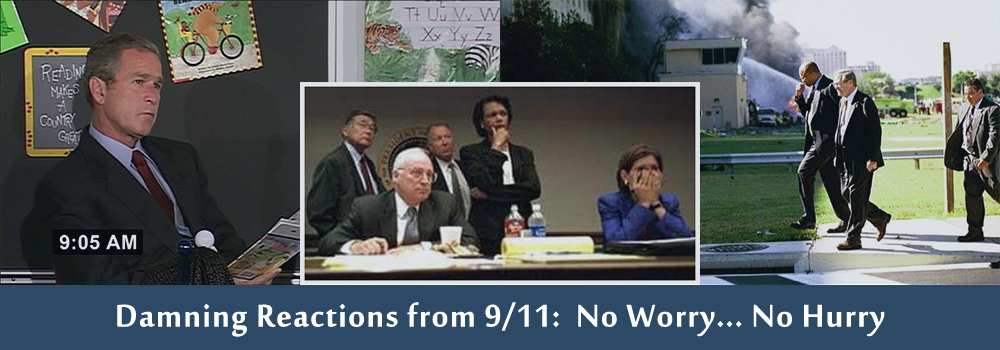 |
||||||||||||||||||||||||||||||||||||||||||||||||


